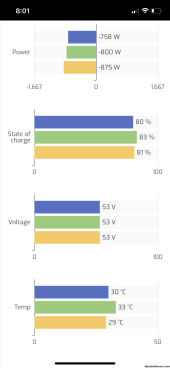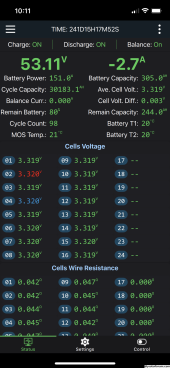I’m reasonably satisfied with my JK’s…now.
I thought I had a problem because my third battery commissioning went a little rougher than the first two JK’s. Something was definitely different with the third and newest bms. The first thing that popped up was the yellow flashing “Change password in time” notification and the layout of the data on the status screen was in different locations. So some firmware changes were probably made. The first two learned what full State Of Charge was after a few cycles but the third was flat out stubborn and got more stupid by the day, losing about 2% capacity readings per cycle. Tried to run that battery up to trip OVP at 3.650 volts and that seemed to work…. For a while. Figure I got a dud bms and ordered another. Install the forth bms and after 5 cycles it became obvious this wasn’t going any better as it was also getting worse by the day. So I decided that dang it, I’m gonna figure out what this JK wants to know to learn what a full state of is. So I went with a hunch. I charged to my regular absorb voltage of 55.2 (3.45 vpc) and knowing that my delta is about .020 when it just gets there, I temporarily lowered the OVP to 3.46 vpc figuring a high cell will trigger it which it did. Got the notification “Battery fully charged” and zing, the SOC went to 100%. Now I’m skeptical because I’ve been here before just to see the SOC fall every cycle. Then I went back in and raised the OVP to 3.55, a place that it would probably never go to.
Well, it’s been more than two weeks and all three batteries get to full state of charge (99%) at the same time and I’m not seeing any weirdness. So I’m thinking that the algorithm wants to see a cell over voltage protected triggered one or two times at your absorption voltage. It also apparently didn’t notice that I moved the OVP up a bit afterwards. I don’t want my last line of defense and the FETs working every cycle. As long as the batteries are all full at the same time, I’m not concerned about the different batteries trading SOC positions a bit during the cycle, they are after all, three different batteries bought at different times so they have different personalities.
I’m 99% ? sure it’s all good from now on.
And….. I got a spare bms.
I thought I had a problem because my third battery commissioning went a little rougher than the first two JK’s. Something was definitely different with the third and newest bms. The first thing that popped up was the yellow flashing “Change password in time” notification and the layout of the data on the status screen was in different locations. So some firmware changes were probably made. The first two learned what full State Of Charge was after a few cycles but the third was flat out stubborn and got more stupid by the day, losing about 2% capacity readings per cycle. Tried to run that battery up to trip OVP at 3.650 volts and that seemed to work…. For a while. Figure I got a dud bms and ordered another. Install the forth bms and after 5 cycles it became obvious this wasn’t going any better as it was also getting worse by the day. So I decided that dang it, I’m gonna figure out what this JK wants to know to learn what a full state of is. So I went with a hunch. I charged to my regular absorb voltage of 55.2 (3.45 vpc) and knowing that my delta is about .020 when it just gets there, I temporarily lowered the OVP to 3.46 vpc figuring a high cell will trigger it which it did. Got the notification “Battery fully charged” and zing, the SOC went to 100%. Now I’m skeptical because I’ve been here before just to see the SOC fall every cycle. Then I went back in and raised the OVP to 3.55, a place that it would probably never go to.
Well, it’s been more than two weeks and all three batteries get to full state of charge (99%) at the same time and I’m not seeing any weirdness. So I’m thinking that the algorithm wants to see a cell over voltage protected triggered one or two times at your absorption voltage. It also apparently didn’t notice that I moved the OVP up a bit afterwards. I don’t want my last line of defense and the FETs working every cycle. As long as the batteries are all full at the same time, I’m not concerned about the different batteries trading SOC positions a bit during the cycle, they are after all, three different batteries bought at different times so they have different personalities.
I’m 99% ? sure it’s all good from now on.
And….. I got a spare bms.







